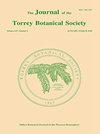Biological soil crust and vascular plant communities in a sand savanna of northwestern Ohio1
IF 0.8
4区 生物学
Q4 PLANT SCIENCES
引用次数: 15
Abstract
NEHER, D. A., T. L. WALTERS, E. TRAMER, T. R. WEICHT, R. M. VELUCI, K. SAIYA-CORK (Department of Earth, Ecological and Environmental Sciences, University of Toledo, Toledo, OH 43606) S. WILL-WOLF (Department of Botany, University of Wisconsin, 430 Lincoln Drive, Madison, WI 53706-1381), J. TOPPIN, J. TRAUB (Whitehouse, Ohio 43571-9803) AND JOHANSEN, J. R (Department of Biology, John Carroll University, University Heights, Ohio 44118). Biological soil crust and plant communities in a sand savanna of northwestern Ohio. J. Torrey Bot. Soc. 130:244-252. 2003. A survey of biological crust components (bryophytes, lichens, chlorophyta, bacteria), soil fauna (nematodes, collembolans, mites) and vascular plants was conducted in a dry sand savanna in northwestern Ohio between 1995 and 2001. In soil, six free-living chlorophytes and seven cyanobacteria taxa were identified. Chlorophyta were more abundant than cyanobacteria with Desmococcus olivaeus and Stichococcus bacillaris being the most common species. For bryophytes, the most common species were Polytrichum piliferum and Ceratodon purpureus, and for lichens, Cladonia species. Notably, we found lichen species in the crusts have chlorophytes not cyanobacteria, as their photobionts. Twenty-seven families and 29 genera of nematodes, and four collembolan species were identified in crust and rhizosphere communities. Autotrophic denitrifying bacteria were not detectable with the method employed. The biological crust occurred among a vascular plant community with Robinia pseudoacacia, Rubus flagellaris, Bromus inermis, and Vicia villosa as the most abundant tree, shrub, graminoid, and non-grass herbaceous plants, respectively. To our knowledge, this is the first report of microbial crust community composition in xeric patches of northwestern Ohio. Moreover, our report includes a report of soil nematode or collembolan communities associated with soil biological crust communities.俄亥俄州西北部沙质稀树草原生物土壤结皮和维管植物群落
NEHER, D. A., T. L. WALTERS, E. TRAMER, T. R. WEICHT, R. M. VELUCI, K. saija - cork(托莱多大学地球、生态与环境科学系,托莱多,俄亥俄州43606)S. WILL-WOLF(威斯康星大学植物系,麦迪逊林肯大道430号,威斯康星州53706-1381),J. TOPPIN, J. TRAUB(怀特豪斯,俄亥俄州43571-9803)and JOHANSEN, J. R(约翰卡罗尔大学生物系,俄亥俄州海茨大学,俄亥俄州44118)。俄亥俄州西北部荒漠草原的生物土壤结皮和植物群落。托里·博特。Soc。130:244 - 252。2003. 1995 ~ 2001年,在美国俄亥俄州西北部的干沙稀树草原进行了生物结皮组分(苔藓、地衣、绿藻、细菌)、土壤动物(线虫、线虫、螨虫)和维管植物的调查。在土壤中鉴定出6种自由生活的绿藻和7种蓝藻。绿藻比蓝藻更丰富,橄榄粘球菌和杆菌属是最常见的种类。苔藓植物中以毛毛多毛和紫角龙最为常见,地衣中以克拉多亚最为常见。值得注意的是,我们发现地壳中的地衣物种有绿藻而不是蓝藻作为它们的光生物。在地壳和根际群落中鉴定出线虫27科29属和线虫4种。该方法未检出自养反硝化细菌。生物结皮发生在维管植物群落中,以刺槐(Robinia pseudoacacia)、毛蕊草(Rubus flagellaris)、雀茅(Bromus inermis)和维管植物薇姬(Vicia villosa)分别为最丰富的乔木、灌木、禾草和非草草本植物。据我们所知,这是俄亥俄州西北部干旱斑块微生物结壳群落组成的第一份报告。此外,我们的报告还包括与土壤生物结皮群落相关的土壤线虫或线虫群落的报告。
本文章由计算机程序翻译,如有差异,请以英文原文为准。
求助全文
约1分钟内获得全文
求助全文
来源期刊
CiteScore
0.70
自引率
0.00%
发文量
16
审稿时长
>12 weeks
期刊介绍:
The Journal of the Torrey Botanical Society (until 1997 the Bulletin of the Torrey Botanical Club), the oldest botanical journal in the Americas, has as its primary goal the dissemination of scientific knowledge about plants (including thallopyhtes and fungi). It publishes basic research in all areas of plant biology, except horticulture, with an emphasis on research done in, and about plants of, the Western Hemisphere.

 求助内容:
求助内容: 应助结果提醒方式:
应助结果提醒方式:


